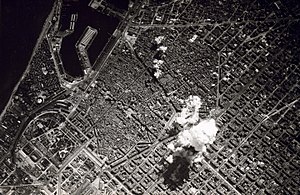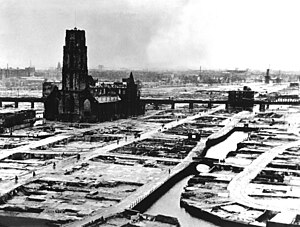Carpet bombing



Carpet bombing, or saturation bombing describes the bombardment of a given area with bombs destroying as much as possible in the given area. Like a carpet that covers the floor, bombs should cover the area. Carpet bombing is usually done by dropping a large number of unguided bombs.
Carpet bombing of cities, towns, villages, or other areas containing a concentration of protected civilians has been a war crime since 1977. [1] It is explained in Article 51 of Protocol I of the Geneva Conventions.[2][3][4]
The term obliteration bombing is sometimes used to describe especially intensified bombing with the intention of destroying a city or a large part of the city. The term area bombing refers to indiscriminate bombing of an area and also encompasses cases of carpet bombing, including obliteration bombing. It was used in that sense especially during World War II and the Korean War.
The use of atomic weapons is automatically a case of carpet bombing in its effect, but there are no modern examples of their use. Their use against Japan in WWII was the last and only example of a real attack using an atomic weapon.
References
- ↑ "Crimes of War – Carpet or Area Bombing". Archived from the original on 2 December 2015. Retrieved 2015-12-08.
- ↑ "Carpet bombing". Britannica.com. Retrieved 21 June 2019.
- ↑ "Treaties, States parties, and Commentaries - Additional Protocol (I) to the Geneva Conventions, 1977 - 51 - Protection of the civilian population". International Committee of the Red Cross. June 8, 1977. Retrieved June 21, 2019.
- ↑ "Treaties, States parties, and Commentaries - Additional Protocol (I) to the Geneva Conventions, 1977 - 51 - Protection of the civilian population - Commentary of 1987". Paragraph 5. International Committee of the Red Cross. Retrieved June 21, 2019.
Bibliography
- Budiansky, Stephen (2004). Air Power: The Men, Machines, and Ideas that Revolutionized War, from Kitty Hawk to Iraq. New York: Penguin Books. ISBN 978-0-670-03285-3.
{cite book}: CS1 maint: location missing publisher (link) - Condor, Albert E (1994). Air Force Gunners (AFGA): The Men Behind the Guns, The History of Enlisted Aerial Gunnery, 1917–1991. Nashville, Tennessee: Turner Publishing. ISBN 978-1-56311-167-9.
- Dick, Ron; Patterson, Dan (2006). Aviation Century: War & Peace In The Air. Eden Prairie, Ontario: Boston Mills Press. ISBN 978-1-55046-430-6.
- Donald, David (1997). The Encyclopedia of World Aircraft. Etobicoke, Ontario, Canada: Prospero Books. ISBN 978-1-85605-375-4.
- Hobson, Chris (2001). Vietnam Air Losses, USAF, USN, USMC, Fixed-Wing Aircraft Losses in Southeast Asia 1961–1973. North Branch, Minnesota: Specialty Press. ISBN 978-1-85780-115-6.
- Hooton, E. R. (2007). Luftwaffe at War; Blitzkrieg in the West. London: Chevron/Ian Allan. ISBN 978-1-85780-272-6.
- Knaack, Marcelle Size (1988). Post-World War II Bombers, 1945–1973 (PDF). Washington, D.C.: Office of Air Force History. ISBN 978-0-16-002260-9.
- Lake, Jon; Styling, Mark (2004). B-52 Stratofortress Units in Combat 1955–73. London: Osprey Publishing. ISBN 978-1-84176-607-2.
- Richard Overy (2013). The Bombing War, Europe 1939-45 (Kindle, 2014 ed.). London: Penguin Books Ltd. ISBN 978-0-141-92782-4.
- Schlight, John (1988). The War in South Vietnam: The Years of the Offensive, 1965–1968 (The United States Air Force in Southeast Asia). Washington, D.C.: Office of Air Force History, United States Air Force. ISBN 978-0-912799-51-3.
Other websites
- "Bombs Over Cambodia" from The Walrus